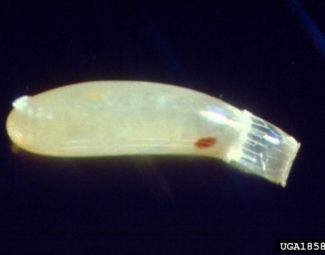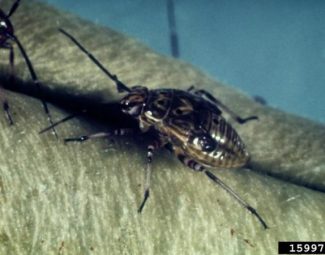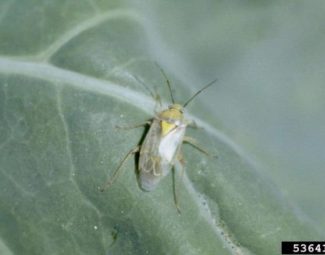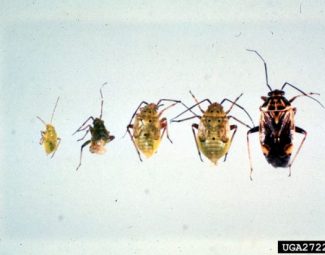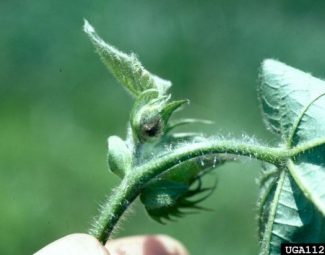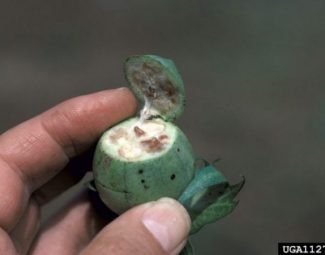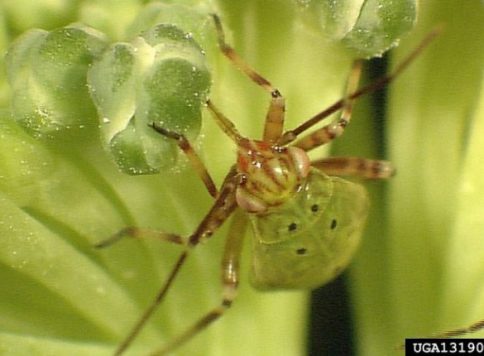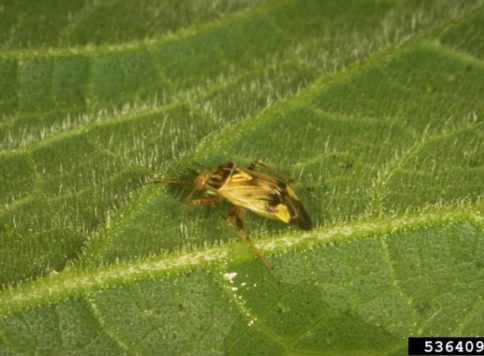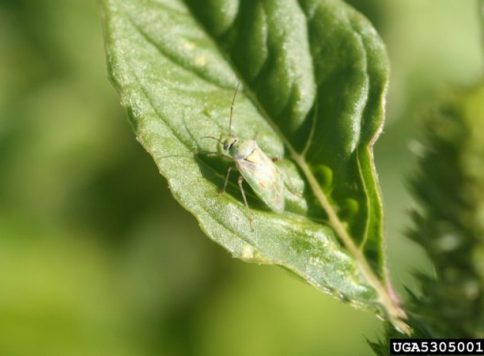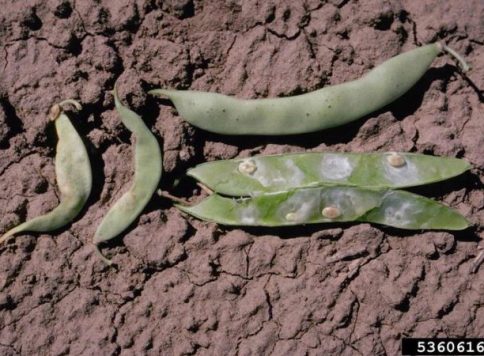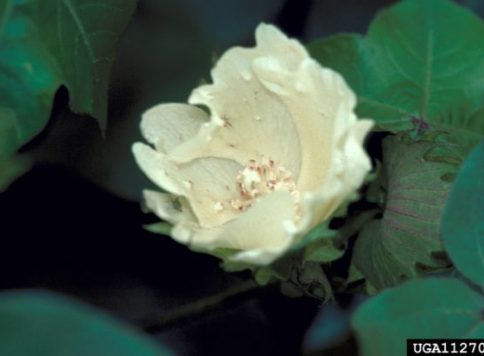Lygus
Insect Summary Report
Lygus hesperus
Lygus lineolaris
Lygus elisus
General Information
- Lygus adults and nymphs pierce flower and fruiting structures.
- They cause malformation, poor pollination and abscission of flowers.
- Deform and discolor fruiting structures. Deformity commonly referred to as “catfacing”
- Piercing can often increase vulnerability of fruit to common diseases.
- Feeding disrupts or ceases seed development and saliva damages immediate area around feeding site by breaking down plant tissue.
- Feeding in terminals can stunt growth of host plant and promote lateral growth that gives infested plants a “bushy” or ragged appearance.
- Wide variety of weed hosts that include: butterweed, fleabane, henbit, goldenrod, vetch, dock, pigweed, dog fennel, Russian thistle, milk thistle, lupines, little mallow, black mustard, curly dock, filaree, lambsquarters, common groundsel, chickweed, London rocket, wild radish, shepherd’s purse, redmaids, pineapple-weed, and goosefoot. Flixweed, London thistle and tumble mustard appear to be the greatest sources of weed hosts in cotton growing areas of Texas.
- Over half of the cultivated plant species grown in the U.S. are hosts of lygus. At least 385 host plants have been identified. Preferred crop hosts include: alfalfa, safflower, sugarbeet, tomato, beans and potato. Other host crops include: cotton, strawberry, conifers, apple, cherry, carrot, peach, pear, artichoke, asparagus, broccoli, cabbage, celery, chard, coriander, corn, cowpea, cucumber, eggplant, endive, escarole, faba bean, fennel, horseradish, lettuce, mustard, onion, parsnip, parsley, pea, pepper, radish, spinach, squash, sweet potato, turnip, watermelon and various nursery ornamentals.
- Winged adults are highly mobile and will migrate from preferred hosts when conditions are no longer conducive for survival (i.e. alfalfa cuttings, dry down, defoliation treatments, harvest, etc.)
- Have been shown to be resistant to many commonly used pesticides.
- A sex pheromone is emitted by females that attracts males. The principle component has been identified as E-2-hexenylbutyrate.
Life Cycle (3-4 Weeks)
- Eggs… (Approx. 7-10 days) 1 mm long. Laid singly inside various parts of host plants, often in petioles or at the base of leaves.
- Nymphs… 5 instars. (Approx. 14 Days) Yellow-green to light green. Later instars have under-developed wings and four black spots on back of thorax.
- Adults… (~ 30 Days) Approx. 5 mm long. Color varies from pale yellow with black marks, to reddish brown, to brown, to black with yellow marks. Prominent triangle is located on back near the head. Movement greatest one hour after sunset and one hour before sunrise.
Over-wintering Strategy
- Over-winter as adults in weed host, dead plant material, leaf litter, tree bark, rock piles, fence lines, and ditch banks, etc. Over-wintering adults are darker in color than other lygus. Become active in spring.
- Monitoring
- Sample flowering and fruiting structures to assess percentage of damage.
- Sweep net can be used to assess numbers of nymphs and adults (25-50 sweeps). Number of nymphs/adults may indicate whether the population is migratory or established infestations.
- Degree-days can be calculated using a lower threshold temp of 54 F.
- Populations tend to be extremely mobile, especially in non-preferred crops, so multiple evaluations are commonly required before treatment decisions are made.
Organic Control
- General Info
- Anaphes iole, a parasitic wasp of lygus eggs is commercially available for augmentative release.
- Natural predators include: big-eyed bugs, damsel bugs, minute pirate bugs, lacewings and spiders.
- Commonly Used Products
- Ferti-Neem Oil
- Ferti-Organics Karanja Oil
- Biorepel (Garlic Oil)
- Neemix 4.5 (Botanical)
- Ecotrol Plus (Rosemary and other essential oils)
- Pyganic 1.4 (Botanical)
- Pyganic 5.0 (Botanical)
- Soaps: Des-X
- Mycotrol ESO (Biological)
- BoteGHA ES (Biological)
Cultural Control
- Maintain good fertility and mineral balance in plants. Identify macro- and micro- nutrient deficiencies by performing plant tissue and soil analysis. Adjust for deficiencies with foliar and soil applied applications of appropriate fertilizers.
- Control weeds and/or lygus populations in and around the perimeter of crops.
- Monitor alternate crops that reside nearby for lygus populations.
- Interplant preferred hosts in crops grown for market.
- Plant strips of preferred hosts between market crop and fields that produce migratory lygus populations.
- Leave strips uncut in crops such as alfalfa to limit immigration to nearby fields.
- Where possible, progress your cutting or harvest in a direction away from fields containing crops that are vulnerable to lygus damage.
- Apply an organic pesticide prior to harvesting an adjacent crop known to have high population levels of lygus.
More Images of the Lygus Bug
Bibliography
- Images by Louis Tedders, USDA Agricultural Research Center, Bugwood.org (Lygus lineolaris adults)
- Image by University of Georgia, University of Georgia, Bugwood.org (mulitple life stages of the Lygus lineolaris)
- Images by Barry Freeman, Auburn University, Bugwood.org (damage to flower, damage to young cotton square, and feeding damage to boll)
- Images by Ronald Smith, Auborn University, Bugwood.org (Lygus lineolaris on daisy fleabane and nymphs)
- Images by Whitney Cranshaw, Colorado State University, Bugwood.org ( adult Lygus elisus on cabbage and on leaf)
- Image by Scott Stewart, University of Tennessee, Bugwood.org (eggs of the Lygus lineolaris)
- Image by John C. French Sr., Retired, Universities:Auburn, GA, Clemson and U of MO, Bugwood.org (nymphs of the Lygus lineolaris)
- Image by Allen Cohen, USDA Agricultural Research Service, Bugwood.org (Lygus lineolaris nymph on broccoli)
- Images by Frank Peairs, Colorado State University, Bugwood.org (lygus feeding on leaf)
- Howard F. Schwartz, Colorado State University, Bugwood.org (damage to bean pods and seeds)
- Godfrey, L. D., P. B. Goodell, E. T. Natwick, and D. R. Haviland, UC IPM Pest Management Guidelines: Cotton, UC ANR Publication 3444, Insects and Mites. University of California-Davis Extension 2008 (Conventional controls, weed hosts, preferred crops, monitoring, resistance) http://www.ipm.ucdavis.edu/PMG/r114301611.html
- Shakirzyanova, G.S., Abdukakharov, V.S., and Abduvakhabov, A.A. 2000. Synthesis of the sex pheromone of Lygus lineolaris (Heteroptera miridae). Chem. Nat. Comp. (Engl. Transl.). 36:623-624.
- Slosser, J. E., E. P. Boring, III, and M. N. Parajulee. 2006. A survey of Lygus spp. in cotton, alfalfa, and roadside weeds in the northern Texas Rolling Plains. Southwestern Entomologist 31: 91-96. (Weed hosts in Texas cotton growing areas).
- Zalom F. G., P. A. Phillips, M.P. Bolda, N. C. Toscano, UC IPM Pest Management Guidelines: Strawberry, UC ANR Publication 3468 Insects and Mites 2008. (Parasitic wasp, natural predators, weed hosts, lower threshold for degree-days).
- Dixon, Wayne N. and T.R. Fasulo. Florida Department of Agriculture and Consumer Services, Division of Plant Industry and the University of Florida. 2006. (Host range, over-wintering, life cycle, weed hosts) http://creatures.ifas.ufl.edu/trees/tarnished_plant_bug.htm
- Diehl, John; Peter Ellsworth, and Leon Moore. Lygus in Cotton Identification: Biology and Management. University of Arizona Cooperative Extension. 1998 (Active periods of adults) . cals.arizona.edu/crops/cotton/insects/lygus/lygus1.pdf

